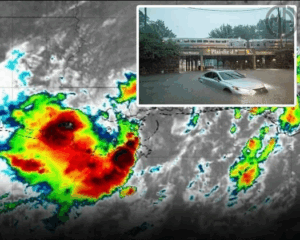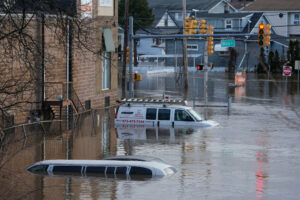A catastrophic super storm is forming and poses an imminent threat to multiple regions across the United States. Meteorologists and emergency agencies are issuing critical alerts as the country braces for what could be one of the most devastating weather disasters in recent decades.

The National Weather Service (NWS), FEMA, and independent meteorological agencies are tracking a massive storm system expected to bring record-breaking rainfall, dangerous flash flooding, powerful wind gusts, and severe thunderstorms — including the potential for tornado outbreaks. The storm, fueled by abnormally warm ocean temperatures and unstable atmospheric conditions, is projected to affect both coasts and large parts of the Midwest and South.

“This could be one of the worst flooding events in recent U.S. history,” said a FEMA spokesperson. “We urge all residents — especially those in low-lying, inland, or coastal areas — to take immediate precautions.”
🌪️ STORM IMPACT ZONES: WHO IS MOST AT RISK?
The storm system is not localized to one area — its nationwide reach is what makes it so dangerous. The most vulnerable zones include:
🔻 East Coast (Carolinas, Georgia, Virginia)
-
3–6 inches of rain expected, with localized areas seeing up to 8+ inches.
-
Urban flooding likely due to poor drainage in historic districts.
-
Coastal cities may face storm surges and tidal flooding during high tide cycles.
🔻 Midwest and Central U.S. (Missouri, Kentucky, Ohio)
-
Riverbanks already swollen from earlier storms are expected to overflow, threatening entire neighborhoods.
-
Infrastructure such as levees and dams are under stress — there is concern about breaches or failures.
🔻 Gulf States and Southeast (Texas, Louisiana, Mississippi)
-
Ground remains oversaturated from deadly floods in June and July. Any additional rainfall could result in instant flash floods.
-
Tornadoes are likely, especially in Texas and Arkansas, as warm Gulf air clashes with descending cold fronts.
💧 WHY THIS STORM IS SO DANGEROUS
This storm system is being powered by multiple climate-related factors converging at once:
-
Ocean temperatures in the Atlantic and Gulf of Mexico are 2–4°C above average, injecting massive amounts of moisture into the atmosphere.
-
A “cut-off low” pressure system is stalling over the central U.S., trapping rain over the same areas for days.
-
Jet stream instability is creating strong wind shear — a key ingredient for tornado formation.
-
In some locations, 24-hour rainfall could exceed monthly averages, triggering mudslides, dam overflows, and severe runoff.
These conditions create the possibility of a “training effect” — where thunderstorms continuously move over the same area, compounding rainfall totals and flood risks.
🚨 GOVERNMENT RESPONSE & EMERGENCY ALERTS
Federal and state emergency management agencies are taking the following actions:
-
FEMA has pre-positioned rescue boats, sandbags, water pumps, and shelters in multiple high-risk areas.
-
National Guard units have been placed on standby in 11 states for possible evacuation assistance and disaster response.
-
Local governments are issuing voluntary and mandatory evacuation orders for areas near rivers, flood plains, and coastal inlets.
-
The National Weather Service has issued Flash Flood Watches and Tornado Warnings across more than 17 states.
In Harris County, Texas, authorities are urging residents to download multiple alert apps and monitor NOAA Weather Radio, due to past failures of cell networks during flood emergencies.
📢 WHAT YOU MUST DO NOW: PREPARE, PROTECT, ACT
If you live in or near an at-risk zone, follow these immediate steps:
✅ 1. Prepare Your Home
-
Place sandbags around doors and drains.
-
Clear gutters and storm drains.
-
Secure outdoor furniture or move it indoors to avoid windborne debris.
✅ 2. Create an Emergency Kit
-
Flashlights, batteries, backup phone chargers, first-aid kit.
-
Bottled water and 3+ days’ worth of non-perishable food.
-
Necessary prescriptions, important documents in waterproof bags.
✅ 3. Know Your Evacuation Route
-
Review local evacuation maps (available from county websites).
-
Avoid driving during heavy rainfall or into standing water — “Turn Around, Don’t Drown.”
-
Plan ahead for pets, elderly family members, or those with mobility challenges.
✅ 4. Stay Informed
-
Follow local news, trusted weather sources, and your city’s emergency management page.
-
Enable Wireless Emergency Alerts (WEA) on your phone.
-
Have a battery-powered weather radio as backup.
📉 A WORSENING TREND: IS THIS THE NEW NORMAL?
Climate scientists emphasize that extreme flooding and super storms are no longer rare events — they’re becoming increasingly common due to:
-
Warming oceans, which provide more moisture for stronger storms.
-
Rising sea levels, which exacerbate coastal storm surge impacts.
-
Aging or inadequate infrastructure, especially in inland towns unprepared for hurricane remnants.
Recent deadly floods in Texas, Kentucky, and the Midwest have revealed deep flaws in America’s flood response — particularly in small towns without updated drainage, siren systems, or evacuation plans.
“We can no longer think of flooding as a ‘coastal’ problem,” said a NOAA scientist. “Anywhere it rains, it can flood.”
🛑 FINAL WARNING
This is not a time for panic — but it is a time for action. With proper preparation and reliable information, many lives can be saved. But do not underestimate this storm. Its wide geographic impact, long duration, and potential for multiple types of disasters — from flash floods to tornadoes to power outages — make it exceptionally dangerous.
Stay alert. Take warnings seriously. Prepare your family now — before the storm hits.
Would you like a version of this article as a printable flyer or in a social media post format? I can help format it for those uses as well.